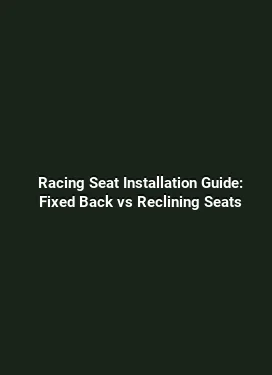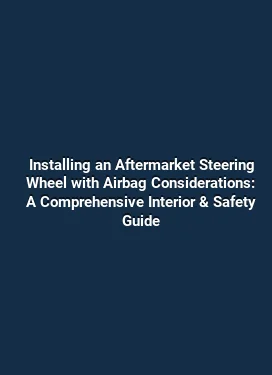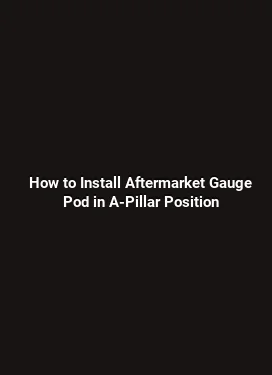Bucket Seat vs Semi-Bucket Seat: Comfort and Support Comparison
Seating comfort and support play a crucial role in the overall driving experience and vehicle ergonomics. The choice between bucket seats and semi-bucket seats can influence long-term comfort, safety, and even occupant well-being on daily commutes or extended journeys. This article examines how design philosophy, materials, and construction affect comfort, lateral support, adjustability, and usability in varied interior setups. By exploring use cases, installation considerations, and maintenance tips, readers gain actionable insights that extend beyond surface descriptions.
Seat Design and Ergonomics Overview

Seat design begins with an assessment of body support, weight distribution, and mobility. Bucket seats are characterized by pronounced side bolsters that cradle the torso and hips, promoting a fixed seating posture during dynamic conditions. In contrast, semi-bucket seats balance containment with a more forgiving side profile, offering moderate lateral support while preserving ease of movement. This fundamental distinction translates into user experiences that vary with posture, vehicle type, and driving style.
Ergonomic considerations extend to cushion depth, backrest curvature, leg support, and lumbar adjustment. A well-engineered seat complements the driver’s line of sight, steering wheel reach, and pedal geometry. Even subtle differences in foam density, cover material, and reinforcement layers can influence muscular fatigue over hours of use. The goal is a seating system that distributes pressure evenly, reduces hotspot formation, and maintains spinal alignment without sacrificing accessibility or comfort for shorter trips.
Comfort and Contour: How Each Design Feels in Practice
Bucket Seats: Containment, Focus, and Drive-Feel

Bucket seats are designed to create a snug, sport-oriented seating envelope. The high side bolsters along the torso and hips guide body position during cornering and quick maneuvers, which can enhance perceived stability. For drivers who value a centered seating position and a feeling of being “wrapped” by the seat, bucket designs deliver a cohesive ride experience. The trade-off is that aggressive bolstering can become intrusive for broader frames or during entry and exit, especially in vehicles with tight cabin geometries.
From a comfort perspective, the firmness of the foam and the support transition between the seat cushion and backrest influence comfort over long periods. If the seat uses a multi-density foam system and well-engineered contouring, users can experience sustained support without excessive pressure points. Materials play a role as well; a breathable cover and properly tuned ventilation channels help manage heat buildup in the hip and thigh regions, which contributes to longer comfort windows on warm days.
Semi-Bucket Seats: Balance, Accessibility, and Everyday Comfort
Semi-bucket seats aim to strike a middle ground: improved lateral support compared to flat bench seating, but with more generous entry points and less restrictive movement than full bucket assemblies. This makes semi-bucket designs particularly well-suited for a wider range of body types and for passengers who value easy ingress and egress. The seat contours typically offer gradual transitions, which can reduce the sensation of confinement while still offering a reassuring hold during dynamic driving scenarios.
In terms of daily comfort, semi-bucket options often pair with adjustability features that streamline the fine-tuning process. Enhanced lumbar support, height adjustment, and seat angle control help users find a comfortable posture without the need for aggressive padding or overly stiff foam. In long-haul scenarios, this translates into sustained lower-back comfort and reduced fatigue, provided the seat materials and padding remain responsive and breathable under prolonged use.
Materials and Build: Durability, Breathability, and Feel
The choice of materials for both bucket and semi-bucket seats affects durability, maintenance, and perceived quality. High-density foams, layered comfort systems, and breathable fabrics or leather alternatives contribute to a seat’s longevity and overall comfort. For performance-oriented layouts, seat shells made from reinforced composites or metal frameworks can offer increased rigidity, which reduces flex under load and helps preserve precise support signals through the spine and hips.
Breathability is a practical concern. Foam density and ventilation channels within the cushion reduce heat retention, which is particularly beneficial for long drives or climates with extreme temperatures. The outer cover material should balance tactile feel with abrasion resistance; materials with good durability minimize micro-tears and pilling, maintaining a smooth seating surface for years. In addition, easy-clean surfaces or removable, washable covers simplify maintenance for households with active lifestyles or shared vehicles.
Adjustability and Personalization
A core differentiator between seat types lies in how users can tailor the seating position to their anatomy. Bucket seats often include deeper backrest recline options and sturdier lumbar supports, with dedicated controls for lateral bolster tension in some configurations. This level of customization supports precise alignment of the pelvis, spine, and neck relative to the steering wheel and pedals. However, excessive bolster aggression or misaligned adjustments can cause discomfort if the user’s torso and hips are not properly supported.
Semi-bucket seats typically offer a broad suite of adjustment options that prioritize accessibility. Height, tilt, and backrest angle adjustments are complemented by seat cushion depth or tilt features in certain models. This translates into a more inclusive fit for drivers and passengers with varying leg lengths and torso heights. The practical effect is an easier setup process that reduces the time needed to achieve a comfortable posture, which can be especially valuable for multi-driver households or fleet applications.
Safety and Support: How Seating Impacts Protection
Protection factors in seat design extend beyond crashworthiness to include posture during everyday driving. Well-contoured side supports can limit lateral motion in the event of abrupt maneuvers, potentially reducing soft-tissue strain. In addition, seat belt routing and anchorage positions work in tandem with seat geometry to promote proper restraint during a collision. A seat that maintains stable geometry under load helps preserve spinal alignment and minimizes compensatory movements that could lead to discomfort or injury.
Heated and ventilated seat options add a thermal regulation layer that can indirectly support safety by keeping muscles relaxed and reducing stiffness on cold mornings or in high-activity situations. For vehicles used in professional settings or with extended occupancy, seat cushions with multi-density foams support consistent energy absorption, which may contribute to occupant comfort and fatigue management during long shifts or trips.
Compatibility, Installation, and Real-World Scenarios
Vehicle architecture dictates how easily bucket or semi-bucket seats can be integrated. Certain car models with fixed seat rails and compact cabin envelopes may present challenges for aggressive bolsters or unique mounting patterns. Conversely, many modern vehicles offer multiple mounting points and adjustable rails that accommodate a variety of seat types. When selecting seats for a specific vehicle, it is important to consider rail compatibility, seat height, and the potential need for aftermarket brackets or professional installation to maintain safety standards and occupant protection systems.
In fleets or shared environments, seat durability and ease of cleaning become practical operational concerns. Semi-bucket seats with simpler fabric and maintenance protocols may reduce downtime and service costs, while bucket seats with premium materials might demand more routine care but can deliver a premium feel and enhanced hold for high-demand driving conditions. It is worth evaluating the balance between initial cost, long-term maintenance, and the expected frequency of seat adjustments by different users.
Maintenance, Longevity, and Everyday Care
Regular inspection of seat padding, foam integrity, and cover condition helps identify early signs of wear. Signs to monitor include uneven cushioning, cracking or sagging in the backrest, and latch or adjustment mechanism wear. Cleaning practices should be aligned with the chosen material: for fabric covers, use a gentle upholstery cleaner and a soft brush to remove surface soil; for leather or synthetic leather, use a conditioner designed for automotive seating to prevent cracking and maintain suppleness. Storage and care routines that minimize prolonged exposure to direct sunlight also contribute to longer seat life and consistent support shapes.
With seat systems that feature electronic adjustments, periodic checks of motor operation and wiring connections are advisable. Smooth, quiet operation across all adjustment axes indicates healthy mechanisms, while unusual noises or sluggish response can signal the need for inspection or servicing. Longevity hinges on maintaining structural integrity and preventing moisture intrusion, which can degrade foam and fabric over time.
Practical Guidance for Choosing Based on Use Case
For drivers who prioritize sportier driving dynamics, a bucket seat with pronounced lateral support can enhance confidence and alignment during spirited driving. Those who frequently share the vehicle with multiple drivers, or who value easy ingress and exit, may lean toward a semi-bucket configuration that offers flexible fit without compromising too much on support. In family vehicles or ride-sharing contexts, the decision might hinge on how often the seat is cleaned and how well the material withstands heavy daily use.
When evaluating options, consider the following practical steps: test sit in the seat for a minimum of 15 minutes to assess comfort across hips, back, and thighs; check how the seat reacts to different adjustability configurations; verify that seat controls are intuitive and accessible from the driver’s seating position; and examine how the seat interacts with the steering wheel, pedals, and dash layout to prevent shoulder or knee fatigue during routine driving tasks.
Maintenance Checklist and Quick Tips
- Inspect bolster integrity and ensure fabric or leather finish remains intact without delamination or cracking.
- Test all adjustability controls for smooth operation and response.
- Clean fabric seats with a gentle cleanser and avoid harsh brushes that could fray fibers; treat leather options with appropriate conditioners.
- Use sun shades or park in shade to minimize UV-induced fading and material degradation.
- Monitor foam density and cushion evenness; address sagging areas promptly to preserve support.
Key Takeaways: Practical Build Quality and User Experience
The choice between bucket and semi-bucket seats rests on a balance between support precision and ease of use. Bucket designs excel in providing a cognitive and physical sense of containment for enthusiasts seeking a sportier feel, while semi-bucket configurations prioritize accessibility, broad compatibility, and comfortable daily use. The ultimate decision should align with body type, driving style, cabin layout, and maintenance expectations. By focusing on ergonomic fit, material quality, and adjustability, occupants can optimize comfort, reduce fatigue, and maintain a healthier posture across varied journeys.






